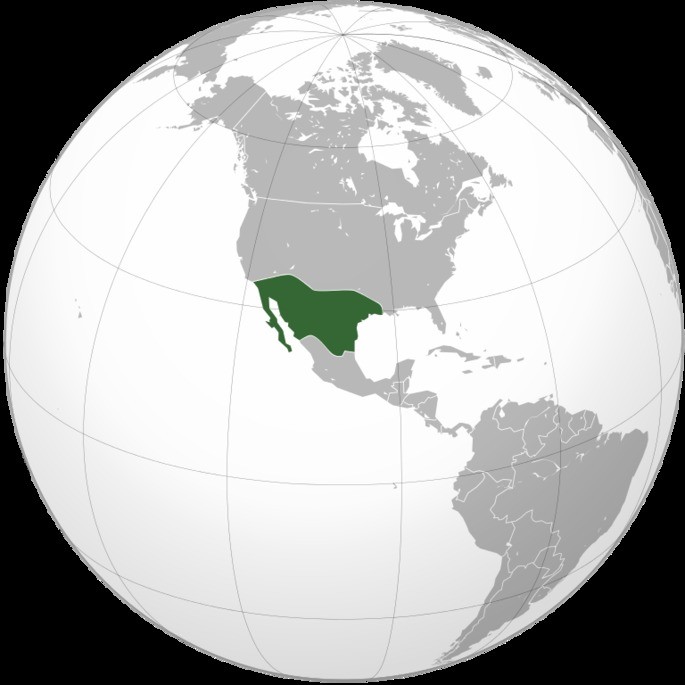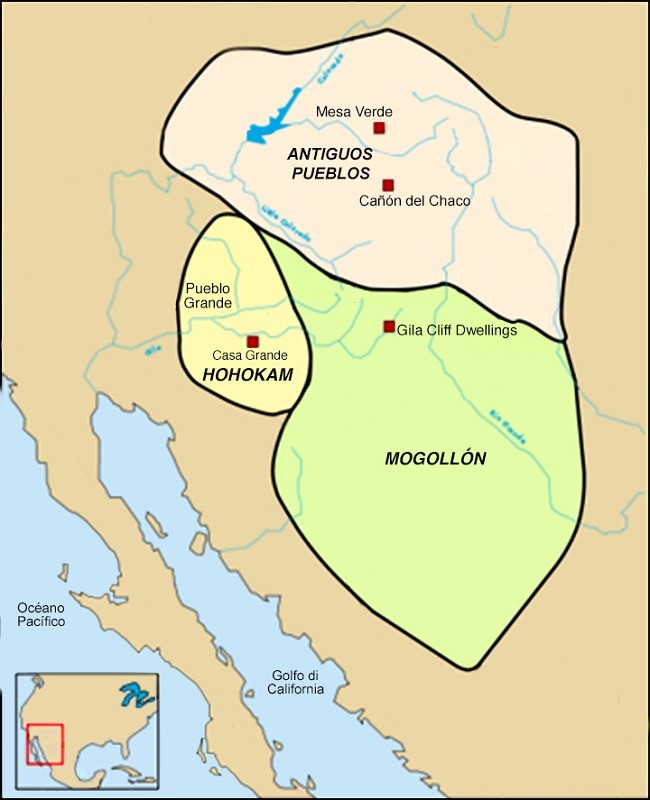Mesoamerica, Aridoamerica, and Oasisamerica were three cultural superareas that occupied what is now Central America, Mexico, and the southwestern United States between 2500 B.C. and 1500 A.D.
Recall that a cultural superarea is a region in which several communities or human groups that share traditions, customs or forms of social organization coexist.
Mesoamerica, Aridoamerica and Oasisamerica had their own natural and geographical characteristics that facilitated the development of various pre-Hispanic cultures, such as the Maya, the Aztecs or the Olmecs, to mention a few.
| Mesoamerica | Arid America | Oasisamerica |
|---|---|---|
| Location: from northwestern Mexico to western Honduras, Nicaragua and Costa Rica. | Location: current Mexican states of Coahuila, Chihuahua and Sonora, as well as part of California and Arizona, in the United States. | Location: present day northern Mexico and southwestern United States |
| Historical period: 1000 BC to 1521 AD. | Historical period: 500 B.C. to 1500 A.D. | Historical period: 1200 to 1341 AD. |
| Climate: temperate, with moderate rainfall. | Climate: dry, with low rainfall and no access to rivers or other water sources. | Climate: dry, with scarce rainfall, but with access to rivers. |
| Subsistence type: sedentary. | Subsistence type: nomadic. | Subsistence type: sedentary. |
|
Cultural legacy
|
Cultural legacy
|
Cultural legacy
|
|
Representative cultures
|
Representative cultures
|
Representative cultures
|
Mesoamerica: the cradle of the Maya, Aztecs and Olmecs.

Mesoamerica was a cultural super-area that spanned from present-day western Honduras, Nicaragua and Costa Rica to the present-day states of Sinaloa and Nayarit in northwestern Mexico.
This region was characterized by the existence of fertile land thanks to the existence of rivers and lakes, which influenced the development of agriculture. In addition, the abundance of natural resources in the area led to the creation of commercial exchange networks between the different societies that coexisted in this super-area.
Three of the most important pre-Hispanic cultures originated in Mesoamerica:
Mayan culture
It was a civilization that developed in what is now Belize, El Salvador, Honduras and southern Mexico. Part of their cultural legacy includes the invention of their own writing system, the invention of the number zero and the creation of cities with a complex architectural design.
The Maya also designed their own system of time measurement expressed in several types of calendars. The most important were the Tzolkin calendar of 260 days, used for agricultural, religious and social purposes, and the Haab calendar of 365 days, which served to keep track of the elapsed years.
Aztec culture
The Aztecs or Mexica were a civilization located in what today would be central Mexico and later expanded to both the north and south of the region. They were characterized by their military and religious organization, their social organization based on hierarchies and their civil works.
The Aztecs were also noted for their time measurement system. They created the 260-day Tonalpohualli calendar, which marked religious dates, and the 365-day Xiuhpōhualli, used to know the dates of harvests and social celebrations.
Olmec culture
It developed in the southeast of what is today the state of Veracruz and the west of Tabasco. They had a hierarchical society and political power was transferred through inheritance, something that did not occur in other civilizations.
Aridoamerica: land of nomads

This cultural super-area encompassed the present-day Mexican states of Coahuila, Chihuahua, Tamulipas, Durango, Zacatecas, San Luis de Potosí, Nuevo León, Baja California, Baja California Sur and Sonora.
It also occupied part of the current states of California, Utah, Nevada, New Mexico, Texas and Arizona, in the United States.
As its name indicates, this region was characterized by its aridity, that is, by the presence of infertile and dry lands due to low or no rainfall and the scarcity of water sources. This prevented the development of agriculture, influencing the adoption of a nomadic way of life based on hunting and gathering.
The cultures that coexisted in Aridoamerica did not have such a notable influence as the Mesoamerican civilizations, since their constant displacements prevented them from leaving a permanent legacy. In addition, they did not coincide in the same historical periods.
Some of the most relevant were the Huichol, Acaxee, Zacatecos, Tepecanos and Tecuexe, among others.
However, historical records demonstrate the existence of a complex religious system and a special treatment of the bodies of the dead. The latter could indicate the existence of some kind of death cult.
Oasisamerica: territory of the Anasazi, Hohokam and Mogollon.

Oasisamerica was a super-area located in what is now northern Mexico and the southwestern United States. It existed from 1200 to 1341 AD.
The societies that developed in Oasisamerica were sedentary and agricultural, just like Mesoamerican societies. However, the geographical and climatic conditions were not so favorable. Their lands were arid and they had to supplement their subsistence system with hunting, fishing and gathering.
Despite the absence of fertile land, the Oasis American cultures knew how to take advantage of their nearby water sources, such as the Bravo, Colorado and Casas Grandes rivers. This was due to the development of water channeling techniques and rainwater storage.
The territory of Oasisamerica was rich in turquoise, a raw material valued by the Mesoamerican culture, which contributed to the strengthening of a solid commercial relationship between the two superareas.
Three of the most relevant cultures of Oasisamerica were:
Anasazi Culture
The Anasazi settled in what are now the states of New Mexico, Colorado, Arizona and Utah in the United States between the 1st century BC and the 16th century AD. They were characterized by their advanced knowledge of architecture and engineering. This allowed them to create large irrigation systems that made agriculture prosper. They also excelled in the creation of multi-story dwellings.
Hohokam Culture
The people who made up the Hohokam culture lived in what are now the deserts of Sonora (Mexico) and Arizona (United States). There are not many records about their way of life, but it is known that they survived the drought and low rainfall of the desert, creating irrigation systems and channeling rivers. This allowed them to cultivate corn, their main source of food, along with pitahaya and mesquite.
Mogollon Culture
The Mogollón thrived in what are now the states of Sonora and Chihuahua in Mexico, and in the areas that are now New Mexico and Texas in the southwestern United States. It is estimated that they existed between 1000 B.C. and 1350 A.D. They were characterized by settling on plateaus and cliffs, as this allowed them to see the advance of their crops. In addition to practicing agriculture, they were dedicated to hunting and gathering.
See also:




